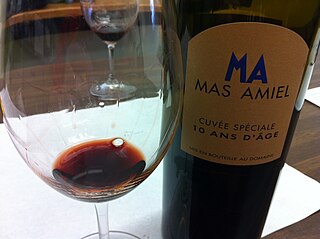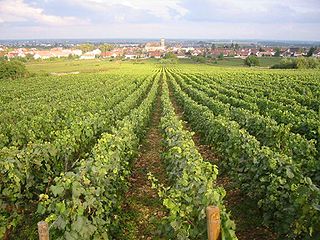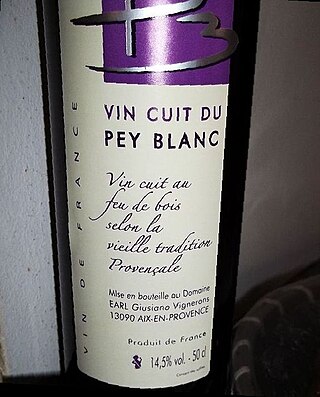Related Research Articles

A drink or beverage is a liquid intended for human consumption. In addition to their basic function of satisfying thirst, drinks play important roles in human culture. Common types of drinks include plain drinking water, milk, juice, smoothies and soft drinks. Traditionally warm beverages include coffee, tea, and hot chocolate. Caffeinated drinks that contain the stimulant caffeine have a long history.

Fortified wine is a wine to which a distilled spirit, usually brandy, has been added. In the course of some centuries, winemakers have developed many different styles of fortified wine, including port, sherry, madeira, Marsala, Commandaria wine, and the aromatised wine vermouth.

Mead, also called hydromel, is an alcoholic beverage made by fermenting honey mixed with water, and sometimes with added ingredients such as fruits, spices, grains, or hops. The alcoholic content ranges from about 3.5% ABV to more than 20%. The defining characteristic of mead is that the majority of the beverage's fermentable sugar is derived from honey. It may be still, carbonated, or naturally sparkling; dry, semi-sweet, or sweet.

Dessert wines, sometimes called pudding wines in the United Kingdom, are sweet wines typically served with dessert.

In cooking, syrup is a condiment that is a thick, viscous liquid consisting primarily of a solution of sugar in water, containing a large amount of dissolved sugars but showing little tendency to deposit crystals. In its concentrated form, its consistency is similar to that of molasses. The viscosity arises from the multiple hydrogen bonds between the dissolved sugar, which has many hydroxyl (OH) groups.

Winemaking or vinification is the production of wine, starting with the selection of the fruit, its fermentation into alcohol, and the bottling of the finished liquid. The history of wine-making stretches over millennia. The science of wine and winemaking is known as oenology. A winemaker may also be called a vintner. The growing of grapes is viticulture and there are many varieties of grapes.

Fruit wines are fermented alcoholic beverages made from a variety of base ingredients ; they may also have additional flavors taken from fruits, flowers, and herbs. This definition is sometimes broadened to include any alcoholic fermented beverage except beer. For historical reasons, mead, cider, and perry are also excluded from the definition of fruit wine.

Red wine is a type of wine made from dark-colored grape varieties. The color of the wine can range from intense violet, typical of young wines, through to brick red for mature wines and brown for older red wines it also goes off if it is sealed or sealed very quickly. The juice from most purple grapes is greenish-white, the red color coming from anthocyan pigments present in the skin of the grape. Much of the red wine production process involves extraction of color and flavor components from the grape skin.

White wine is a wine that is fermented without skin contact. The colour can be straw-yellow, yellow-green, or yellow-gold. It is produced by the alcoholic fermentation of the non-coloured pulp of grapes, which may have a skin of any colour. White wine has existed for at least 4,000 years.

A rosé is a type of wine that incorporates some of the color from the grape skins, but not enough to qualify it as a red wine. It may be the oldest known type of wine, as it is the most straightforward to make with the skin contact method. The pink color can range from a pale "onionskin" orange to a vivid near-purple, depending on the grape varieties used and winemaking techniques. Usually, the wine is labelled rosé in French, Portuguese, and English-speaking countries, rosado in Spanish, or rosato in Italian.

Maury is an Appellation d'Origine Contrôlée (AOC) for fortified vin doux naturel wines made in the Roussillon wine region of France. Almost all wines are red, made from at least 75% Grenache noir (Garnacha). Other permitted grapes are Grenache blanc, Grenache gris, Macabeu (Macabeo), Malvoisie du Roussillon (Tourbat), Syrah, Muscat and other local varieties. Although the grapes are different, they are used and marketed very much like port. It is made in the communes of Maury, Saint-Paul-de-Fenouillet, Lesquerde, Tautavel and Rasiguères. The AOC was granted in 1936.

Kilju is the Finnish word for home made alcoholic beverage typically made of sugar, yeast, and water.

Pineau des Charentes, is a regional aperitif of western France, made in the départements of Charente, Charente-Maritime, and Dordogne. While popular within its region of production, it is less well known in other regions of France and somewhat uncommon abroad.
The glossary of wine terms lists the definitions of many general terms used within the wine industry. For terms specific to viticulture, winemaking, grape varieties, and wine tasting, see the topic specific list in the "See also" section below.

The following outline is provided as an overview of and topical guide to wine:
The classification of wine is based on various criteria including place of origin or appellation, vinification method and style, sweetness and vintage, and the grape variety or varieties used. Practices vary in different countries and regions of origin, and many practices have varied over time. Some classifications enjoy official protection by being part of the wine law in their country of origin, while others have been created by, for example, growers' organizations without such protection.

Marsannay wine is produced in the communes of Marsannay-la-Côte, Couchey and Chenôve in the Côte de Nuits subregion of Burgundy. The Appellation d'origine contrôlée (AOC) Marsannay may be used for red and rosé wine with Pinot noir, as well as white wine with Chardonnay as the main grape variety. Red wine accounts for the largest part of the production, around two-thirds. Marsannay is the only village-level appellation which may produce rosé wines, under the designation Marsannay rosé. All other Burgundy rosés are restricted to the regional appellation Bourgogne. There are no Grand Cru or Premier Cru vineyards in Marsannay. The Marsannay AOC was created in 1987, and is the most recent addition to the Côte de Nuits.

Cider is an alcoholic beverage made from the fermented juice of apples. Cider is widely available in the United Kingdom and the Republic of Ireland. The UK has the world's highest per capita consumption, as well as the largest cider-producing companies. Ciders from the South West of England are generally higher in alcoholic content. Cider is also popular in many Commonwealth countries, such as India, South Africa, Canada, Australia, and New Zealand. As well as the UK and its former colonies, cider is popular in Portugal, France, Friuli, and northern Spain. Germany also has its own types of cider with Rhineland-Palatinate and Hesse producing a particularly tart version known as Apfelwein. In the U.S. and Canada, varieties of alcoholic cider are often called hard cider to distinguish it from non-alcoholic apple cider or "sweet cider", also made from apples. In Canada, cider cannot contain less than 2.5% or over 13% absolute alcohol by volume.
This glossary of winemaking terms lists some of terms and definitions involved in making wine, fruit wine, and mead.

Vin cuit or cooked wine is an artisanal dessert wine produced in Provence, France. It is made by heating grape juice without boiling it so that the grape juice becomes concentrated and syrupy. It is then fermented in barrels. The alcohol content is around 14%.
References
- ↑ Bokesa, Ciríaco (1987). Voces de espumas (in Spanish). Centro Cultural Hispano-Guineano. ISBN 978-84-398-9331-8.
- ↑ Tekam, François (2016-01-07). "Cameroun : le marché prospère des liqueurs traditionnelles". Pressenza (in French). Retrieved 2022-10-25.
- ↑ Lepengue, Alexis Nicaise; Mokea-Niaty, Aurélien; Ikabanga, Davy U.; Lingombe, Roland; Ontod, Dhert Souviens Tshi-Tshi; Nzengue, Ephrem; Mombo, Stéphane; Yala, Jean Fabrice; Souza, Alain; Mbatchi, Bertrand (2020-06-19). "Effet de Garcinia kola (Clusiaceae) dans les processus de fermentation du vin de canne à sucre (Saccharum officinarum; Poaceae) au Gabon". International Journal of Biological and Chemical Sciences. 14 (3): 1074–1084. doi: 10.4314/ijbcs.v14i3.33 . ISSN 1997-342X. S2CID 225726189.
- ↑ Lemps, Alain Huetz de (2001). Boissons et civilisations en Afrique (in French). Presses Univ de Bordeaux. ISBN 978-2-86781-282-8.